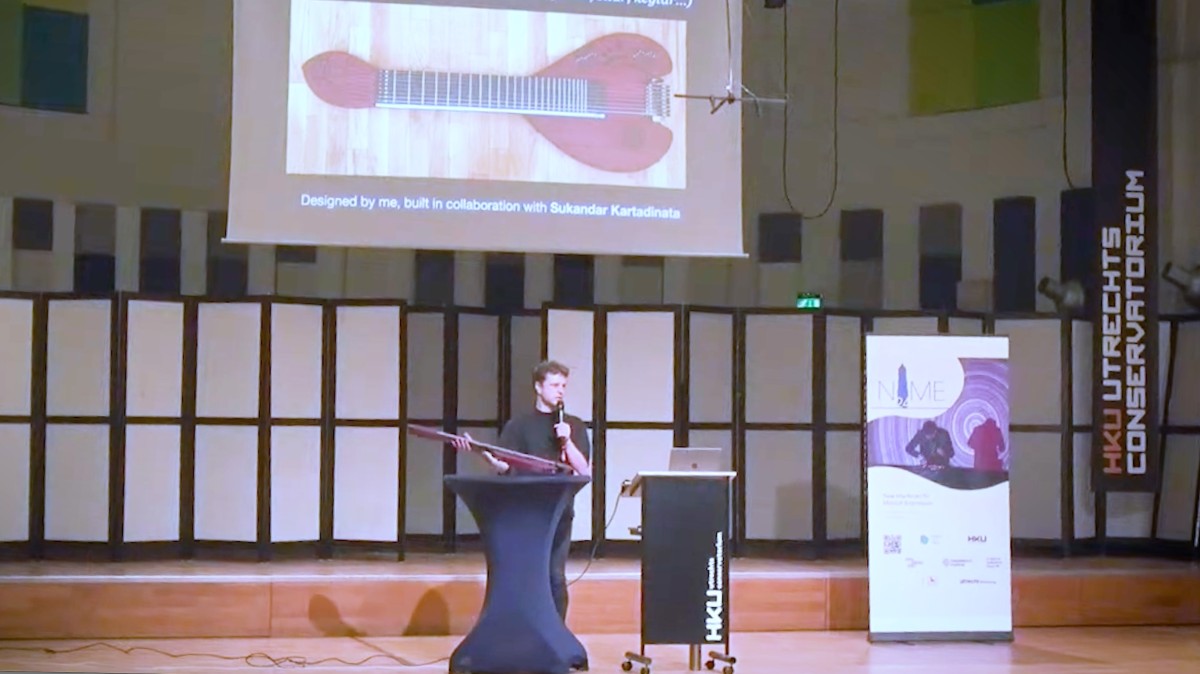Next week is NIME week! This year I am not going – Canberra is way too far from Berlin – but I finally got around uploading my presentation from last year’s conference though, which took place in Utrecht, the Netherlands. Features the Sophtar and a somewhat pretentious digression about magic, ergodynamics, and a quote from a book by Benjamin Labatut I was reading on my way there. Here is the paper!
Category: Events
-

TCP/Indeterminate Place quartet performs Reconciliation at Studio Acusticum
On Monday 9 June 2025 the TCP/Indeterminate Place quartet performed Reconciliation, a piece we composed in 2024 for a special double duo telematic performance in which two of us performed at the Kapelle der Versöhnung in Berlin and the other two at the Orgelpark in Amsterdam. This time we were all at the Studio Acusticum main concert hall, playing our instruments and interacting with the massive Acusticum/University pipe organ in several ways. I experimented with the pressure aftertouch of the Sophtar as a way of adding and subtracting stops to the registration of the IV manual of the organ. Here is short snippet I recorded with my phone during sound check.
TCP/Indeterminate Place is:
Mattias Petersson: parsimonia, live coding, hyperorgan
Stefan Östersjö: midi electric guitar, hyperorgan
Robert Ek: augmented clarinet, hyperorgan
Federico Visi: sophtar, hyperorganOur performance was a prelude Mattias Petersson’s successful PhD defence titled “The Act of Patching” that took place the following day.








-
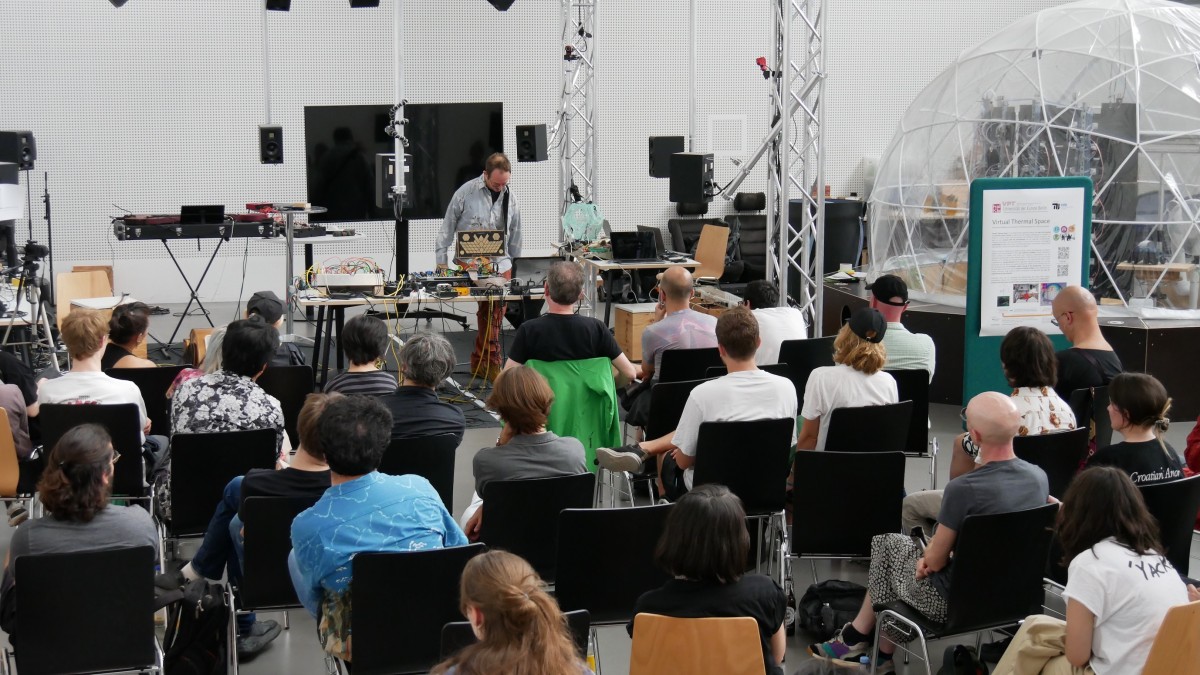
Videos from the Embedding Algorithms Workshop
I have made a YouTube playlist with videos from the Embedding Algorithms Workshop.
The event took place in July 2024 at Universität der Künste Berlin, we brought together a community of artists, researchers, and practitioners and had a great time discussing the practice of embedding algorithms in the arts with presentations, exhibitions, and performances. Enjoy!
Full playlist:
-
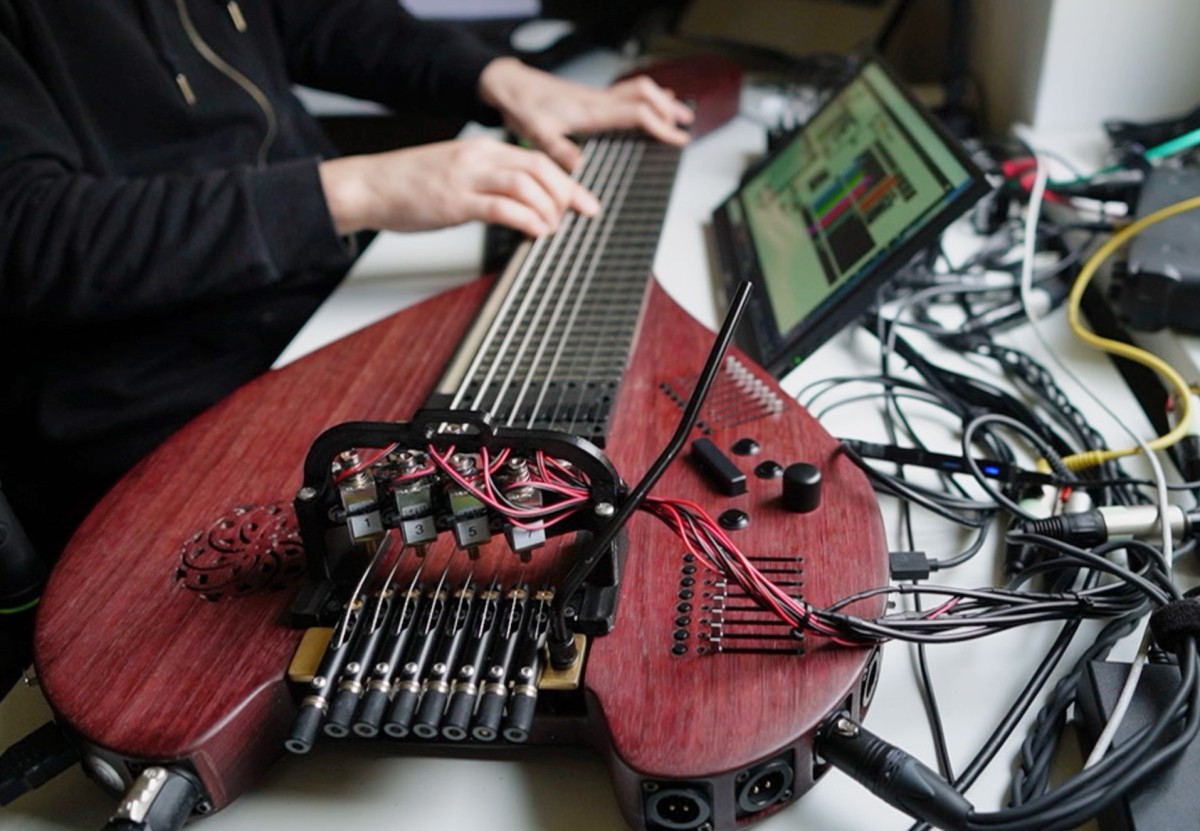
The Sophtar at the Guthman Musical Instrument Competition
The Sophtar has been selected as one the ten finalists in this year’s Guthman Musical Instrument Competition.
Together with Sukandar Kartadinata, we will bring the instrument to the Georgia Tech campus in Atlanta (US) to present it to the competition’s judges and participate in a public performance involving local Atlanta musicians.
I designed the Sophtar and built it in collaboration with Kartadinata. At the Intelligent Instruments Lab, the Sophtar was extended with actuators, on-board DSP, and machine learning models to make it respond to the player in ways that are not easy to predict yet meaningful and inspiring.
Read more about the Sophtar here and check out all the finalists in this year’s compeition here.
The Sophtar has been developed with the support of the GEMM))) research cluster at Luleå University of Technology, the Intelligent Instruments Lab at University of Iceland, the European Research Council, the Swedish Research Council, the Boström Fund, and the Helge Ax:son Johnsons foundation.
-

Wilding AI Lab, CTM 2025
Next week I will take part in the Wilding AI Lab:
this four-day lab will assemble a group of participants selected via open call to learn about the application of generative AI in spatial audio, and collectively explore the wilder territories of AI. Shaped as a mix of theoretical and hands-on components, the lab runs 23 – 25 January, and culminates with a public presentation session Sunday 26 January.
The lab will take place at MONOM, a unique performance venue and spatial audio studio housed at Funkhaus Berlin. It consists in a 3D array of omnidirectional speakers arranged on columns and subwoofers placed underneath the audience, beneath an acoustically transparent floor.

MONOM (Ph: Becca Crawford, from 4dsound.net.) I am pretty excited about experimenting with the Sophtar there, particularly given that each of its eight strings and the audio synthesis machine learning models can be routed to separate output channels, making it possible to place each sound source in a different point in space.

The Sophtar (Ph: Federico Visi). I look forward to meeting the other participants in person. Engaging with a community of practitioners, share skills and ideas, and take part in an open critical discussion on AI- and data-driven tools is crucial to address the rapid changes affecting our cultural landscape. I believe it is also very important to open the process to the public in order to demystify the black boxes, promote critical thinking, spread knowledge, and offer new narratives, so I am excited at the prospect of an open lab on the fourth day. As in Maurice Jones’ words during our first collective Zoom meeting “the design of how we gather is essential.”
Participants
- Daniel Limaverde
- Evangeline Y Brooks
- Federico Visi
- Gadi Sassoon
- Hyeji Nam
- Irini Kalaitzidi
- Nico Daleman
- Ninon and Jun Suzuki
- SENAIDA
- Three Amps
- Transient Cat
- TWEE
Hosts
-
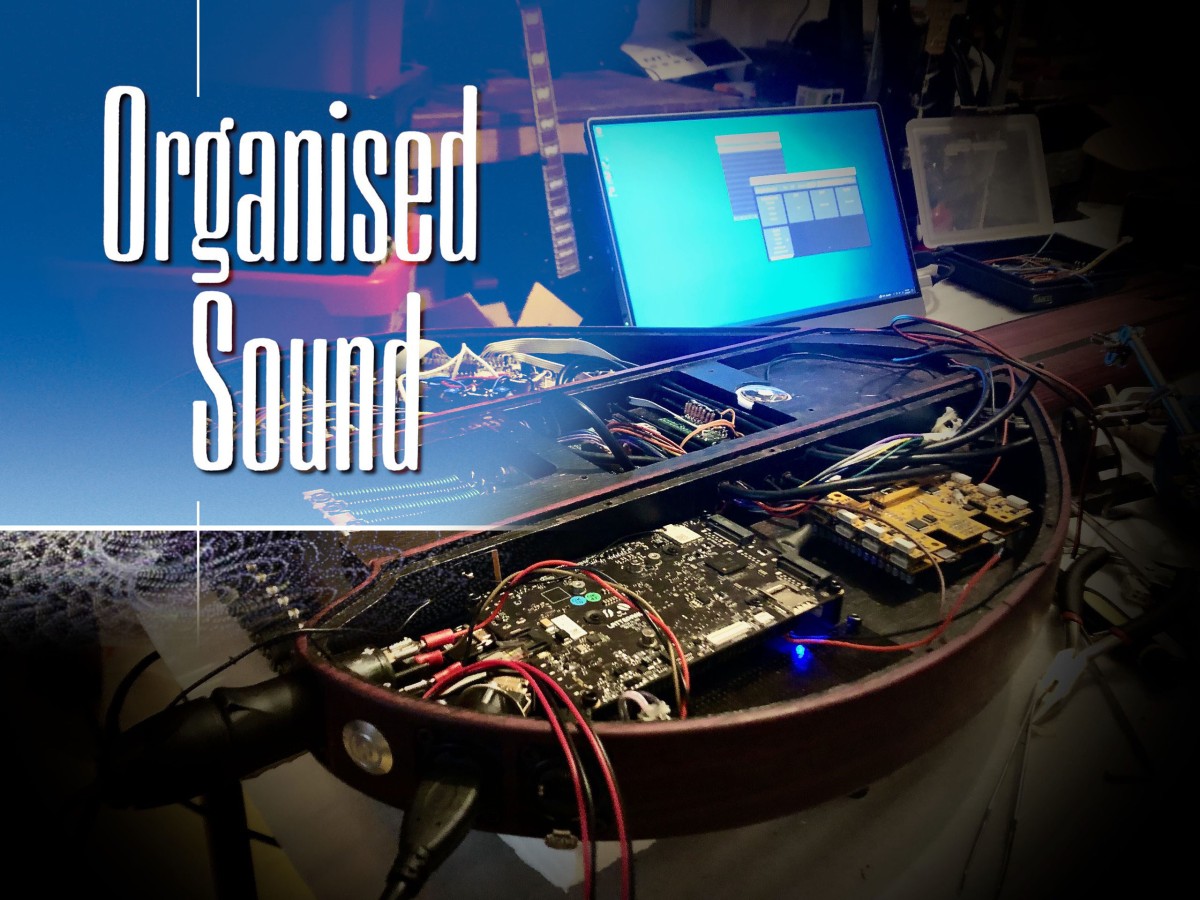
Organised Sound – Call for papers: Embedding Algorithms in Music and Sound Art
Excited to announce that I am co-editing with Thor Magnusson a thematic issue of Organised Sound on the topic of Embedding Algorithms in Music and Sound Art.
Please find the full call below and on the journal’s website.The idea of a journal edited issue came after the Embedding Algorithms Workshop that took place at the Berlin Open Lab in July 2024.
Feel free to share this call with others who might be interested in contributing.We look forward to receiving your submissions!
Call for Submissions – Volume 31, Number 2
Issue thematic title: Embedding Algorithms in Music and Sound Art
Date of Publication: August 2026
Publishers: Cambridge University Press
Issue co-ordinators: Federico Visi (mail@federicovisi.com), Thor Magnusson (thormagnusson@hi.is)
Deadline for submission: 15 September 2025Embedding Algorithms in Music and Sound Art
Embedding algorithms into physical objects has long been part of sound art and electroacoustic music practice, with sound artists and researchers creating tools and instruments that incorporate some algorithmic process that is central to their function or behaviour. Such practice has evolved profoundly over the years, touching many aspects of sound generation, electroacoustic composition, and music performance.Whilst closely linked to technology, the practice of embedding algorithms into tools for sound making also transcends it. Different forms and concepts emerge in domains that can be analogue, digital, pertaining to recent or ancient technologies, tailored around the practice of a single individual or encompassing the behaviours of multiple players, even non-human ones.
The processes and rules that can be inscribed into instruments may include assumptions about sound and music, influencing how these are understood, conceptualised, and created. Algorithms can encode complex behaviours that may make the instrument adapt to the way it is being played or give it a degree of autonomy and agency. These aspects can have profound effects on the aesthetics and creative processes of sound art and electroacoustic music, as artists are given the possibility of delegating some of the decisions to their tools.
In the practice of embedding algorithms, knowledge and technology from other disciplines are appropriated and repurposed by sound artists in many ways. Sensors and algorithms developed in other research fields are used for making instruments. Similarly, digital data describing various phenomena – from environmental processes to the global economy – have been harnessed by practitioners for defining the behaviour of their sound tools, resulting in data-driven sound practices such as sonification.
More recently, advances in artificial intelligence have made it possible to embed machine learning models into instruments, introducing new aesthetics and practices in which curating a dataset and training a model are part of the artistic process. These trends in music and sound art have sparked a broad discourse addressing notions of agency, autonomy, authenticity, authorship, creativity and originality. There are aesthetic, epistemological, and ethical implications arising from the practice of building sound-making instruments that incorporate algorithmic processes. How do intelligent instruments affect our musical practice?
This demands an interdisciplinary critical enquiry. For this special issue of Organised Sound we seek articles that address the aesthetic and cultural implications that designing and embedding algorithms has on electroacoustic music practice and sound art. We are interested in the role of this new technological context on musical practice.
Please note that we do not seek submissions that describe a project or a composition without a broad contextualisation and an underlying central question. We instead welcome submissions that aim at addressing one or more specific issues of relevance to the call and to the journal’s readership which may include works or projects as examples.
Topics of interest include:
- Aesthetics in performance of instruments with embedded algorithms
- Phenomenology of electroacoustic performance with algorithmic instruments
- Agency, autonomy, intentionality, and “otherness” of algorithmic instruments
- Co-creation and authorship in creative processes involving humans and algorithmic instruments
- Dynamics of feedback, adaptivity, resistance, and entanglement in player-instrument-algorithm assemblages
- Human-machine electroacoustic improvisation
- Critical reflections on the role of algorithms in the creation of sound tools and instruments and their impact on electroacoustic music practice
- Meaning making, symbolic representations, and assumptions on music and sound embedded within instruments and sound tools
- Knowledge through instruments: epistemic and hermeneutic relations in algorithmic instruments
- Appropriation, repurposing, and “de-scripting” of hardware, algorithms, and data by sound artists
- Exploration of individual and collective memory through algorithmic instrumental sound practice
- Roles and understandings of the machine learning model as a tool in instrumental music practice
- Use of algorithmic instruments in contexts informed by historical and/or non-Western traditions
- Ethics, sociopolitics, and ideology in the design of algorithmic tools for electroacoustic music
- Legibility and negotiability of algorithmic processes in electroacoustic music practice
- Non-digital approaches: embedding algorithms in non-digital instruments
- Postdigital and speculative approaches in electroacoustic music practice with algorithmic instruments
- Data as instrument in electroacoustic music practice: curating and embedding data into instruments
- Aesthetics and idiosyncrasies of networked, site-specific, and distributed instruments and performance environments
- Entanglement, inter-subjectivity, and relational posthumanist paradigms in designing and composing with algorithmic instruments
- More-than-human, inter-species, and ecological approaches in algorithmic instrumental practice
Furthermore, as always, submissions unrelated to the theme but relevant to the journal’s areas of focus are always welcome.
SUBMISSION DEADLINE: 15 September 2025
SUBMISSION FORMAT:
Notes for Contributors including how to submit on Scholar One and further details can be obtained from the inside back cover of published issues of Organised Sound or at the following url: https://www.cambridge.org/core/journals/organised-sound/information/author-instructions/preparing-your-materials.General queries should be sent to: os@dmu.ac.uk, not to the guest editors.
Accepted articles will be published online via FirstView after copy editing prior to the full issue’s publication.
Editor: Leigh Landy; Associate Editor: James Andean
Founding Editors: Ross Kirk, Tony Myatt and Richard Orton†
Regional Editors: Liu Yen-Ling (Annie), Dugal McKinnon, Raúl Minsburg, Jøran Rudi, Margaret Schedel, Barry Truax
International Editorial Board: Miriam Akkermann, Marc Battier, Manuella Blackburn, Brian Bridges, Alessandro Cipriani, Ricardo Dal Farra, Simon Emmerson, Kenneth Fields, Rajmil Fischman, Kerry Hagan, Eduardo Miranda, Garth Paine, Mary Simoni, Martin Supper, Daniel Teruggi, Ian Whalley, David Worrall, Lonce Wyse
-
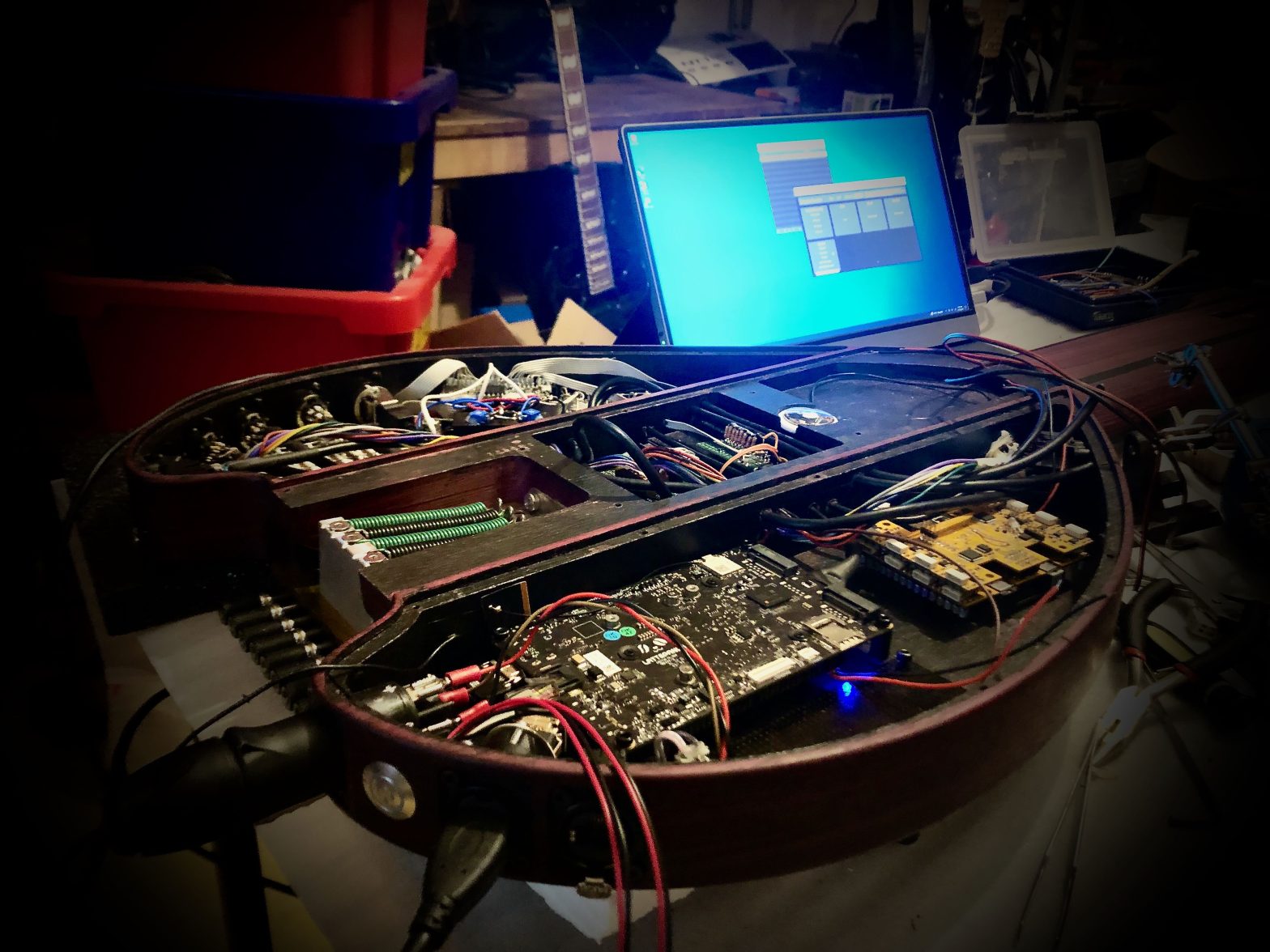
Embedding Algorithms Workshop
EDIT: following the workshop, we’re now co-editing a thematic issue of Organised Sound on the topic. Here is the call.
EDIT: here are some videos recorded during the event.
The Embedding Algorithms Workshop is an informal meeting of researchers and practitioners working with embedded systems in the fields of musical instrument design, wearable computing, interaction design, and performing arts. During the workshop, the participants will show and discuss:
- designing physical objects (instruments, wearables, and more) that incorporate some algorithmic process that is central to their function or behaviour;
- designing and implementing embedded algorithms;
- using/performing/practising with objects with embedded algorithms;
- and more.
Time: Friday, 26th July 2024, 10:00-18:00
Place: Universität der Künste Berlin – Berlin Open Lab – Mixed Reality Space (aka BOL2) – Einsteinufer 43, 10587 Berlin.
NB: There is a large construction site in front of Einsteinufer 43. Once you have found your way around it and entered the building, go past the reception and through the glass doors. Turn left at the end of the corridor and go past another set of glass doors. BOL 2 is at the very end of the long corridor you will find ahead of you, last door on the right.The event is open and free to attend. Please register here just so we can get a better idea of how many people to expect.
More info: mail(at)federicovisi(dot)comOverall schedule:
10:00 – 12:30: presentations/discussions (session 1)
12:30 – 13:30: exhibitions introduction and lunch break
13:30 – 16:00: presentations/discussions (session 2)
16:00 – 16:30: coffee break, exhibitions
16:30 – 18:00: performances and closing remarksPresenters
(15 min + 10 min Q&A each, distributed in 2 x 2.5-hr sessions)
In no particular order:
- Andrew McPherson
- Teresa Pelinski & Adam Pultz Melbye
- Alberto de Campo & Bruno Gola
- Federico Visi
- Echo Ho
- Eliad Wagner
- Viola Yip
- Nicola Hein
- John MacCallum
- Zora Kutz & Stratos Bichakis
- Friederike Fröbel & Malte Bergmann
Talks
In no particular order:
Alberto de Campo & Bruno Gola: “From intuitive playing to Absolute Relativity – How tiny twists open possibilities for Multi-Agent Collaborative performance”
This talk discusses the sequence of small twists in the long-term development of the NTMI project that opened up new perspectives. These turning points include the idea of replacing analytical control with intuitive influence, opening the interface options from a single custom device to various common interfaces, the idea to enable these influence sources to work simultaneously.
The latest step, adapting the influence mechanisms to be consistently relative, creates further options for multi-agent performance, including networks of influence sources and destinations, which may extend to nonhuman actors.Eliad Wagner: “Modular synthesisers as cybernetic objects in musical performance”
This presentation (performance demonstration accompanied by discussion) is a result of an ongoing artistic research on the topic. Its focus is twofold: the material algorithms that govern the cybernetic machine behaviour (sound creation) and the human gestures (incl. the points of control that allow them) that facilitate form and meaning.
Central to the examination is the embedding of patch algorithms within the modular synthesiser, an instrument that lacks established techniques, canon, or prescribed usage. Each such interaction with the synthesiser reinvents its structure and interface, resulting in a constant process of instrumental grammatization. In this context, improvisation emerges as a useful and even necessary method for responding to the uncertainty and unpredictability of the machine. In a sense, the embedded algorithm informs both counterpart behaviours – machine and human, and potentially transforms the identity of the human component- from control to participation.Echo Ho: “Can Ancient Qin Fingering Methods Inspire AI Engineering for New Musical Expressions?”
This short presentation explores the convergence of ancient Chinese qin-fingering methods and modern AI/ML techniques. The PhD project “qintroNix” reinterprets historical qin learning methods for contemporary art and music. The qin, a seven-stringed instrument with a three-millennia history, uses classifiers inspired by natural phenomena to depict fingering techniques. These classifiers, representing animals and plants, serve as mnemonic devices and metaphorical maps, linking physical movements with musical expression and philosophical models.
The project speculates on integrating these ancient techniques into modern AI/ML frameworks. Like ancient classifiers distilled natural phenomena into musical gestures, AI/ML algorithms extract and model features from large datasets. This parallel provides a framework for developing AI/ML systems with human-interpretable metaphors, enhancing pattern recognition and classification transparency.
Exploring phenological phenomena in qin music fosters an ecological consciousness, connecting musicians with an other-than-human world. This entangled approach aligns with contemporary efforts to bridge organic and digital realms; combining archaic knowledge with contemporary technology can unlock new possibilities for imagination, innovation, and a more profound understanding of music’s role in our world.Viola Yip: “Liminal Lines”
In Viola Yip’s latest solo work “Liminal Lines”, she developed a solo performance with her self-built electromagnetic feedback dress. This feedback dress is made of non-insulated audio cables attached to a soft PVC fabric. These cables allow audio signals to pass through. The signal is first captured by an electromagnetic microphone, and then the captured signals pass through guitar pedals and a mixer, and eventually back to the dress to complete the feedback loop. Her body, when wearing the dress, facilitates a wide range of distances, pressures, and speeds through her physical engagement (touching, squeezing, stretching, etc.). These body-and-instrument interactions physically manipulate the interferences and modulations of the electromagnetic fields, which allow various complex sonorities to emerge and modulate over time.
In this symposium, she develops a new lecture performance with this dress, in which she will dive into her journey with physical touch, materialities and spaces within and surrounding the wearable instrument and the performer’s body.Andrew McPherson: “Of algorithms and apparatuses: entangled design of digital musical instruments”
Digital musical instruments are often promoted for their ability to reconfigure relationships between actions and sounds, or for those relationships to incorporate forms of algorithmic behaviour. In this talk, I argue that these apparently unlimited possibilities actually obscure strong and deeply ingrained ideologies which lead to certain design patterns appearing repeatedly over the years. Some such ideological decisions include the reliance on spatial metaphors and unidirectional signal flow models, and the supposition that analytical representations about music can be inverted into levers of control for creating it. I will present some work-in-progress theorising an alternative view based on Karen Barad’s agential realism, particularly Barad’s notions of the apparatus and the agential cut. In this telling, algorithmic instruments are not merely measuring and manipulating stable pre-existing phenomena; they are actively bringing those phenomena into existence. On closer inspection, the boundaries between designer and artefact, instrument and player, materiality and discourse, are more fluid than they first appear, which offers an opening for new approaches to design of algorithmic tools within and beyond music.
Nicola L. Hein: “Cybernetic listening and embodiment in human-machine improvisation”
In this talk, I will show and discuss several pieces of mine which operate within the domain of human-machine improvisation using musical agent systems. The focus of this talk will be the changing parameters of cybernetic listening, interaction, and embodiment between human and machine performers. By using my own works, which employ purely software-based musical agents, visual projections and light, robots, and varying perceptual modalities of musical agents as a matrix of changing parameters of the situated human-machine interaction, I will argue for the importance of embodiment as a central concern in musical human-machine improvisation. The term cybernetic listening will help to further elaborate on the systemic components of musical performance and interaction with musical agent systems.
Federico Visi: “The Sophtar: a networkable feedback string instrument with embedded machine learning”
The Sophtar is a tabletop string instrument with an embedded system for digital signal processing, networking, and machine learning. It features a pressure-sensitive fretted neck, two sound boxes, and controlled feedback capabilities by means of bespoke interface elements. The design of the instrument is informed by my practice with hyperorgan interaction in networked music performance. I discuss the motivations behind the development of the instrument and describe its structure, interface elements, and the hyperorgan and sound synthesis interactions approaches it implements. Finally, I reflect on the affordances of the Sophtar and the differences and similarities with other instruments and outline future developments and uses.
Teresa Pelinski and Adam Pultz Melbye: “Building and performing with an ensemble of models”
How can we then treat machine learning models as design material when building new musical instruments? Many of the tools available for embedding machine learning in musical practice have fixed model architectures, so that the practitioners’ involvement with the models is often limited to the training data. In this context, the design material appears to be the data. From a developer’s perspective, however, when training a model for a specific task, a ‘model’ does not refer to a single entity but to an ensemble instead: the architecture is trained varying the number of layers, blocks or embedding sizes (the hyperparameters), and training-specific parameters such as learning rate or dropout.
For the last month we have been working on a practice-based research project involving the FAAB (feedback-actuated augmented bass), the ai-mami system (AI-models as materials interface) and a modular synthesiser. In this talk, we will discuss our process when building this performance ensemble, our insights in using machine learning models as design material, and finally, the technical infrastructure of the project.John MacCallum: “OpenSoundControl Everywhere”
In this talk/demo I will preview OSE, a lightweight, dynamic OpenSoundControl (OSC) server designed for rapid prototyping in heterogeneous environments. Since its development over 25 years ago, OSC has been a popular choice for those looking to expose software and hardware to dynamic control. OSC itself, however,
is not dynamic—seamless integration of new nodes into an existing network is challenging, and OSC servers are not typically extensible at runtime. This lack of dynamism stands increasingly in the way of truly rapid prototyping in fields such as digital musical instrument design. OSE provides a solution to this challenge by implementing a general purpose OSC server that itself is an OSC server, allowing for dynamic control and configuration. I will discuss briefly some implications for design with such a system, the state of the current work, and its future.Exhibitions
(the exhibitions will be briefly introduced right before the lunch break)
- Zora Kutz and Stratos Bichakis: Beads Beats
- Friederike Fröbel, Malte Bergmann: Student projects, MA Interface Cultures, Kunstuniversität Linz
Zora Kutz & Stratos Bichakis: “Beads Beats”
As one of the earliest forms of fabric decoration, found separately in cultures across the world, beading provides a rich history of techniques and materials that fit well with creating interactive textiles. Sensitive to touch and pressure, capacitive sensing allows for a range of input that can then be used for a variety of applications. In this project, we wish to create an artefact not unlike a musical instrument, used to control both synthetic soundscapes and the spatialisation of audio material. Along the process we are documenting findings for both the types of interaction we are researching, as well as the material and construction specifications.
Friederike Fröbel & Malte Bergmann: “Experiments with textile interfaces and found sounds”
This exhibition presents projects that explore meaningful sound interactions through textile-tangible interfaces using digital sound processing techniques. They were developed in two courses of the Masters Programme Interface Cultures at the University of Art and Industrial Design in Linz, Austria. The annual course explores the relationship between technology, fashion, craft and design with a particular focus on the idea of dynamic surfaces and soft circuits and how these can be realised through various textile processing techniques such as knitting, weaving, embroidery and many more. The course consisted of experimenting and exploring textile processing techniques using capacitive sensors and designing novel interaction prototypes with soft interfaces. Students worked on projects using Bela Mini, Trill Craft and Pure Data. Each student brought a personal field recording and a piece of clothing or textile to which they had a particular attachment. The materials students brought ranged from fish leather and stomach rumbles to suitcases and the rattling sounds of railway bridges. These materials would be ‘upcycled’ and combined as part of the group work, where they would be collectively combined to use soft textile sensing to generate expressive and playful ways of using clothing as a sound interface.
Performances
(~1 hour in total at the end of the workshop)
- Echo Ho and Alberto de Campo
- Adam Pultz Melbye and Teresa Pelinski
- Eliad Wagner
- Federico Visi
- Absolute Relativity – flatcat, Kraken, nUFO, and more, group and audience welcome to play
- Nicola Hein
-
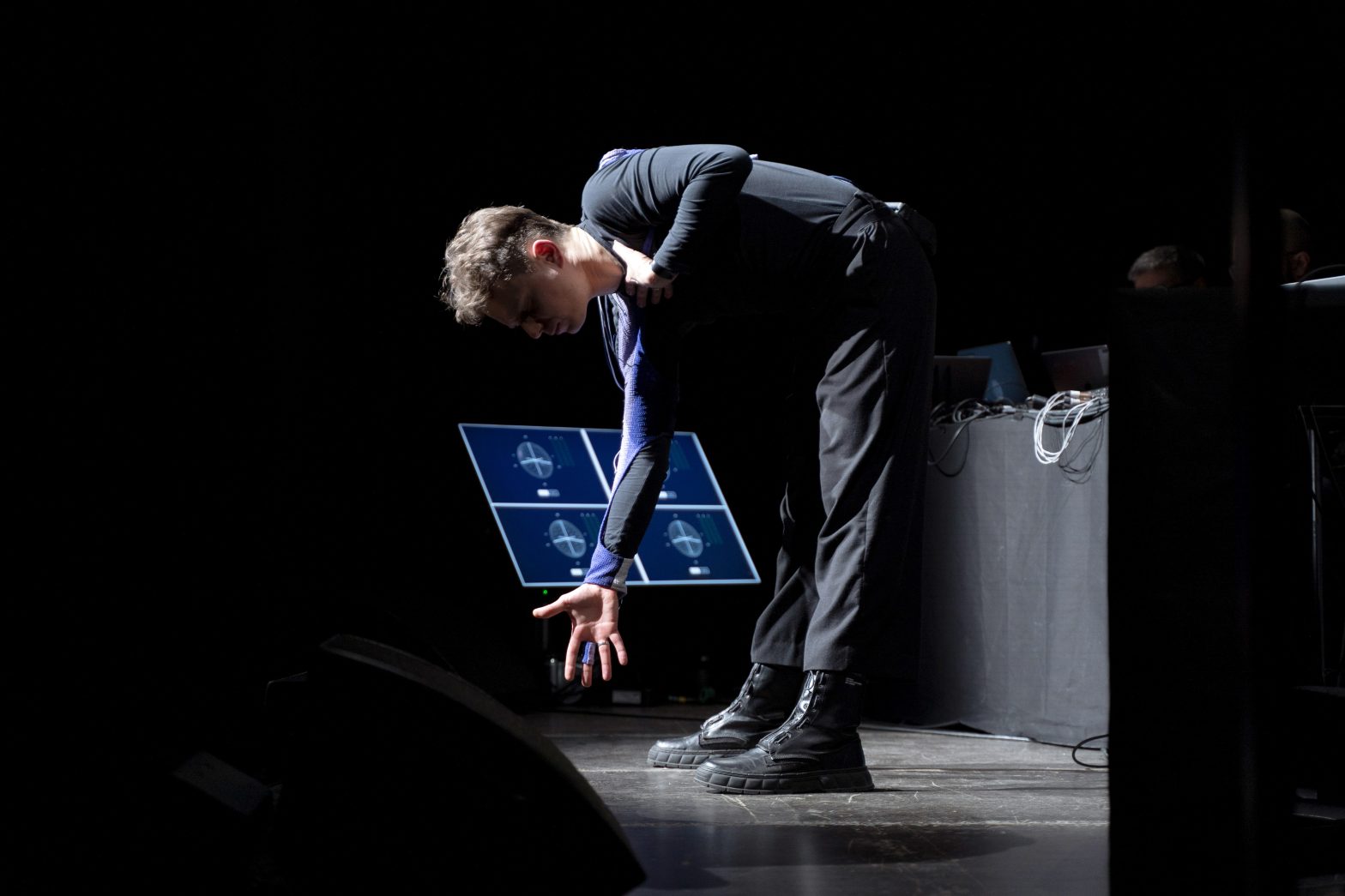
Photos from CTM 2024
From the performance of Swirling Qubits with Eduardo R. Miranda and Paulo Itaboraí at Radial System for CTM 2024. Part of the Wave Dysfunction event on Quantum Computer Music.
I performed with the Tensile interactive garment designed by Codi Körner, knitted by Emma Wood and developed at the UdK Wearable Computing Group for Interwoven Sound Spaces. The movements of my arm were captured by the garment and changed the qubits of a synth connected to a quantum computer.
Photos: Goethe-Institut Irland / Alicja Hoppel.




-
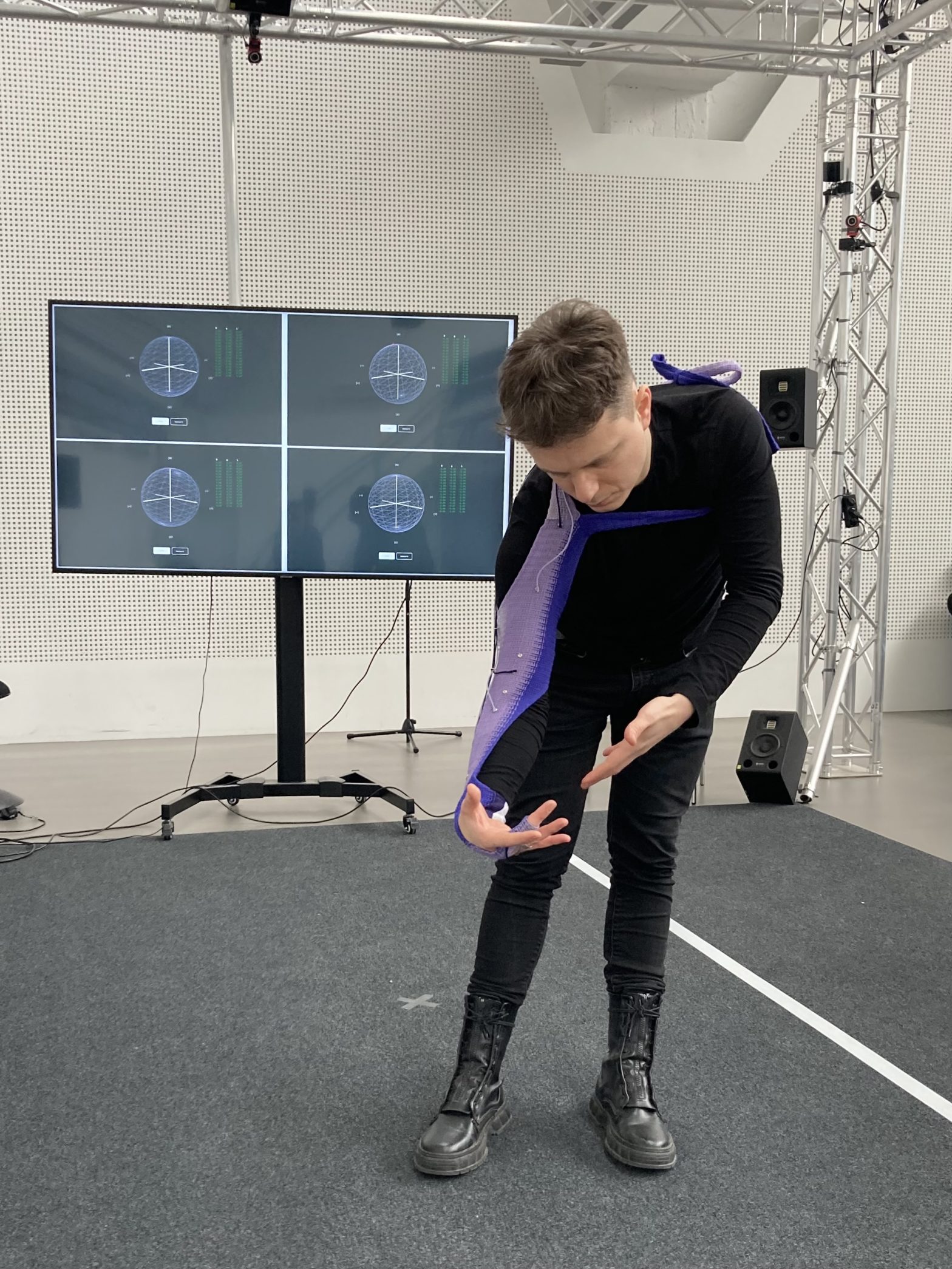
Performing Swirling Qubits by Eduardo Miranda at ECDF and CTM Festival, Berlin
Two gigs in Berlin this coming week: I am performing Swirling Qubits by Eduardo Reck Miranda at the Einstein Centre for Digital Future on Tuesday 30 January and at Radialsystem on Friday 2 February for CTM Festival. Here are some pictures from the rehearsals with Eduardo, Maria Aguado, and Paulo Itaborai at the Berlin Open Lab. I am going to use the Tensile wearable that we have developed at the UdK Wearable Computing group for the Interwoven Sound Spaces project. From CTM programme notes:
A quantum computer deals with information encoded as quantum bits – or qubits. The qubit is to a quantum computer what a bit is to a digital one: it is a basic unit of information. In hardware, qubits live in the subatomic world. They are subject to the laws of quantum mechanics. Thus, qubits process information in fundamentally different and potentially more powerful ways than digital bits. Quantum computing is bound to open new and exciting opportunities for creative practices. For the performance, a state-of-the-art quantum computer, developed by IQM, will be used to run generative music algorithms and to synthesise sounds. Performers will control the quantum computer based in Finland with gestures, brain signals and live coding through the Internet. Vintage analogue synthesisers in Brazil will produce sounds transmitted to Berlin in real-time.”
The programmes include more Quantum Computer Music pieces by Eduardo Miranda, Paulo Itaborai, Dino Vicente, Pete Thomas, and Colin Harrington.
I did my PhD with Eduardo at the Interdisciplinary Centre for Computer Music Research (ICCMR), University of Plymouth, from 2013 to 2016. It’s great to work with him again here in Berlin after quite a few years.


-
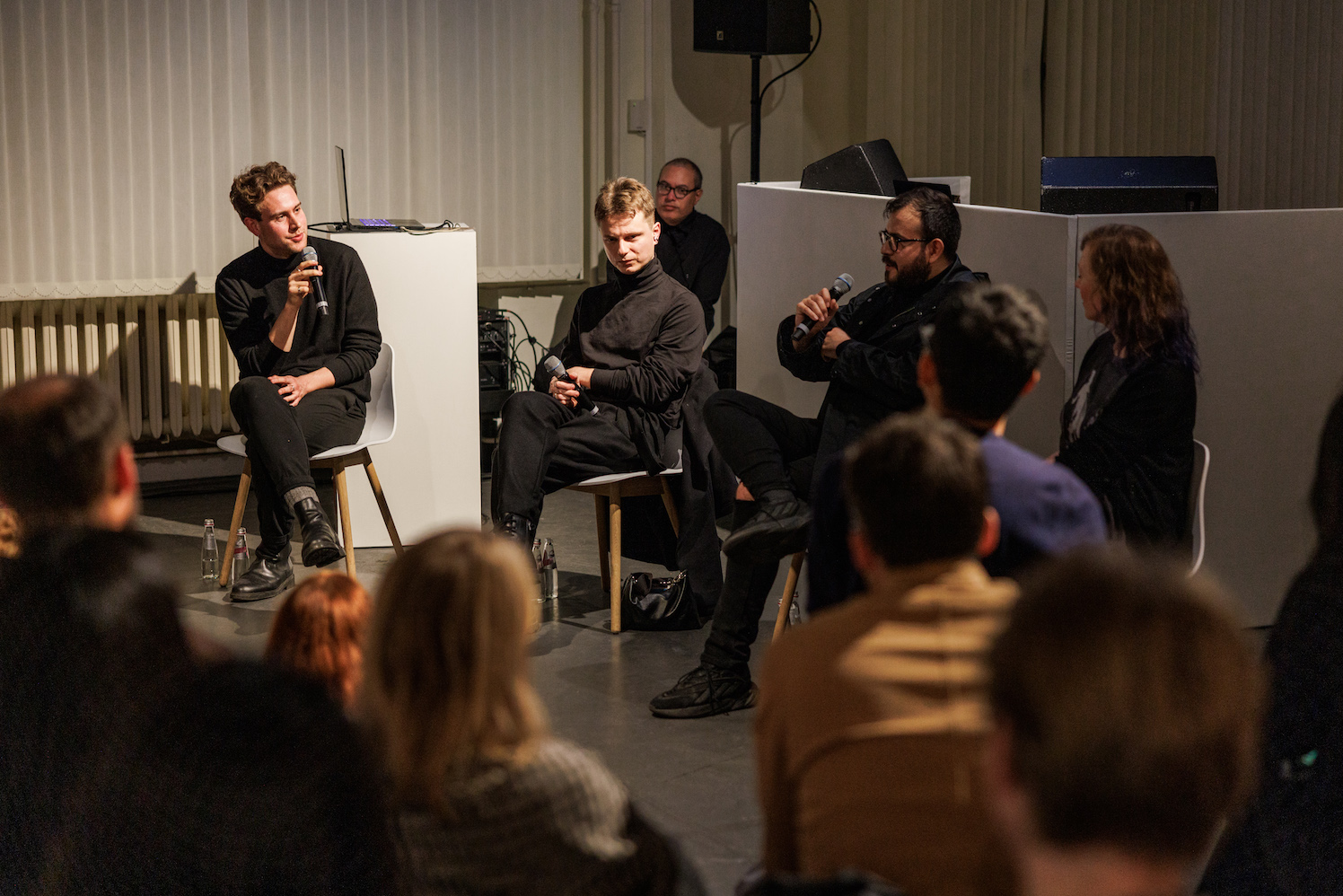
Photos from Machined Music
A few photos from the Machined Music event at Berlin Science Week: talk with Moisés Horta Valenzuela, Tom Burgert, and myself moderated by Claudia Schnugg followed by a performance by Moisés AKA Hexorcismos using Semilla. Event curated by Micheal Fowler.
Photo credit: Berlin Science Week/Ole Spata, 2022.







